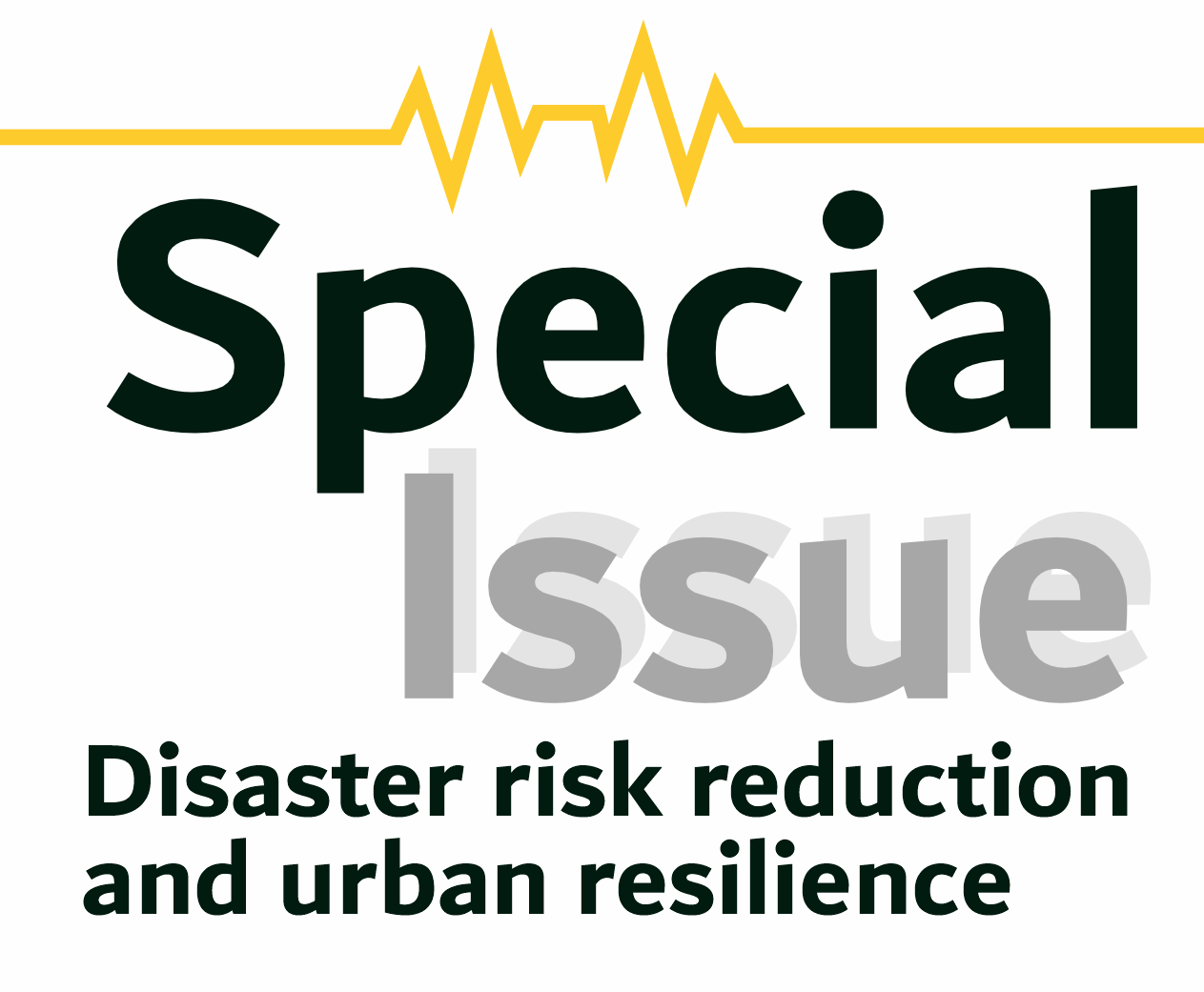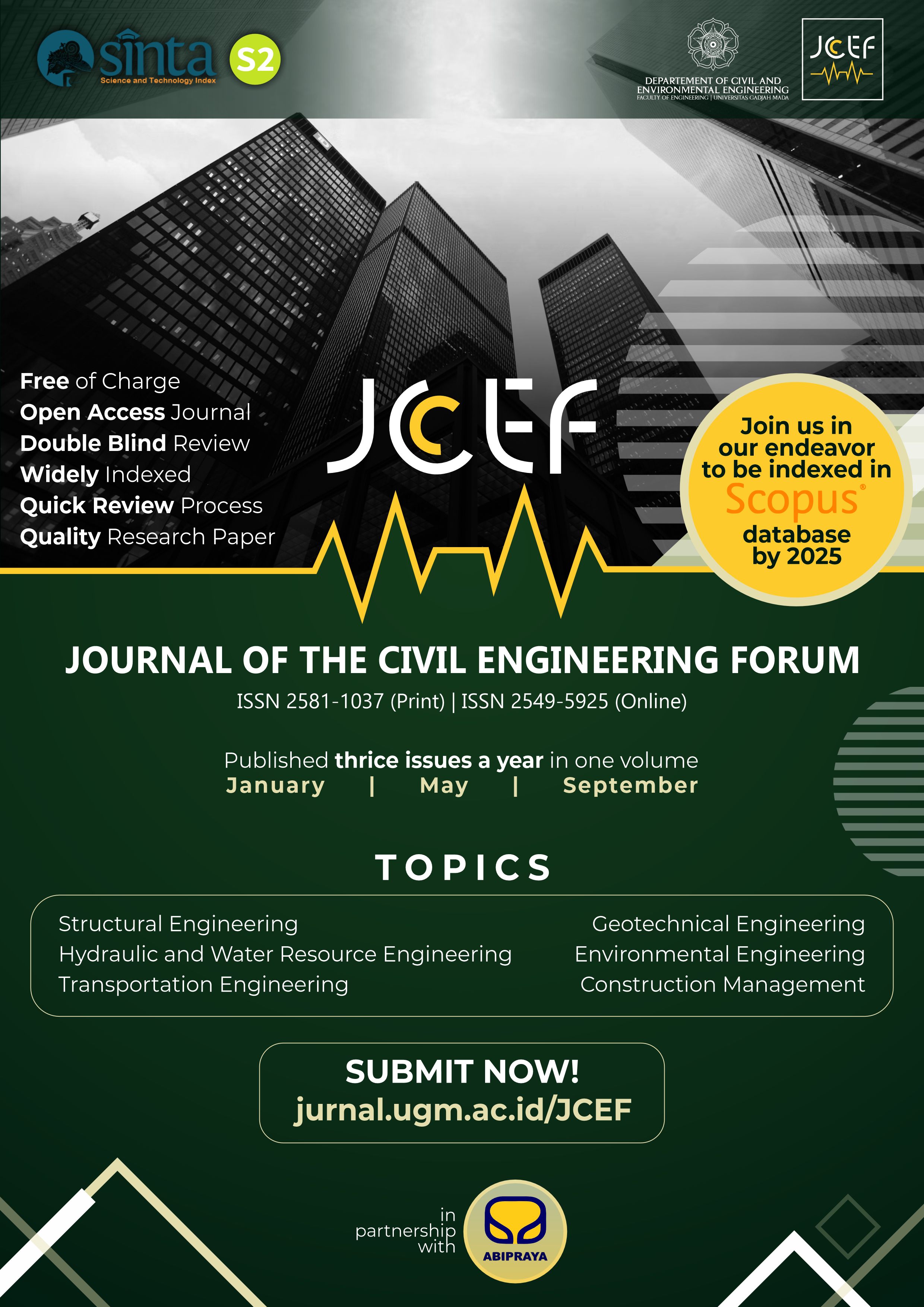Finite Element Analysis of Bi-directional Shear Panel Damper with Square Hollow Section under Monotonic Loading
Abstract
This study aims to determine the finite element analysis of a BSPD-SHS (bi-directional shear panel damper with a square hollow section) device, to dissipate the seismic excitation energy through the lateral relative displacement between the pier and girder of the simple support bridge. The configuration of the square hollow section is also performed for a double role, such as web panel and flange, indicating the expectations to reduce the seismic force within the lateral and longitudinal directions. In the preliminary development phase, the finite element analysis was conducted under monotonic loading, to examine the skeleton curve characteristics and internal stress action on resisting seismic force. The characteristics of this curve include elastic stiffness, shear strength, post-yield behavior, and internal stress distributions. Based on the evaluation of the BSPD-SHS slenderness effect, the variation of depth-thickness ratio was considered between 25 to 67. To investigate the fitness of the theoretical shear strength formulation, two different hardening roles of the metal plasticity model were subsequently compared in this study, including the elastic-perfectly plastic and isotropic/kinematic techniques. Furthermore, the effect of the restrained degree of freedom idealization on the top base plate was captured. This indicated that all specimens model with the restrained top base plate achieved stable post-yield stiffness. In implementing the unrestrained top base plate, this stiffness was achieved when the web slenderness ratio equaled 25. The differences observed between the hardening roles also generated a slight yield shear strength discrepancy. However, significant differences occurred in the post-yield shear strength. The shear resistance proportion of the stress components was also accurately quantified with an analytical stress integration. Based on the restrained top base plate, the flange tension field generated a significant contribution to the post-yield shear resistance.
References
Abebe, D. Y., Kim, J. W., Gwak, G. and Choi, J. H. (2019), ‘Low-cycled hysteresis characteristics of circular hollow steel damper subjected to inelastic behavior’, International Journal of Steel Structures 19(1), 157–167.
AISC (2016a), ‘Seismic provisions for structural steel buildings’, Chicago, Illinois, USA: American Institute of Steel Construction (AISC) pp. 341–16.
AISC (2016b), ‘Seismic provisions for structural steel buildings’, Chicago, Illinois, USA: American Institute of Steel Construction (AISC) pp. 360–16.
Chaboche, J.-L. (1986), ‘Time-independent constitutive theories for cyclic plasticity’, International Journal of plasticity 2(2), 149–188.
Chan, R. W., Albermani, F. and Williams, M. S. (2009), ‘Evaluation of yielding shear panel device for passive energy dissipation’, Journal of Constructional Steel Research 65(2), 260–268.
Chaofeng, Z., Youchun, W., Longfei, W. and Meiping, W. (2017), ‘Hysteretic mechanical property
of low-yield strength shear panel dampers in ultra-large plastic strain’, Engineering Structures 148, 11–22.
Chen, Z., Ge, H. and Usami, T. (2006), ‘Hysteretic model of stiffened shear panel dampers’, Journal of structural engineering 132(3), 478–483.
Chen, Z., Ge, H. and Usami, T. (2007), ‘Study on seismic performance upgrading for steel bridge structures by introducing energy-dissipation members’, Journal of Structural Engineering, A 53, 540–549.
Dassault-Systèmes, A. (2011), ‘Standard analysis user’s manual’, Dassault Systèmes Simulia Corp., Providence, RI, USA.
Dowling, N. E. (2013), Mechanical Behavior of Materials. 4th ed. Harlow: Pearson Education, Pearson Education.
Effendi, M. K. (2020), Non-linear finite element analysis of flexural reinforced concrete beam using embedded reinforcement modeling, in ‘Journal of the Civil Engineering Forum’, Vol. 6, pp. 271–284.
Ge, H., Chen, X. and Kang, L. (2012), ‘Demand on stiffened steel shear panel dampers in a rigid-framed bridge pier under repeated seismic ground motions’, Advances in Structural Engineering 15(3), 525–546.
Hashimoto, K., Otsuka, K., Sugiura, K., Sugiyama, Y. and Kanaji, H. (2016), ‘Effect of structural parameters of shear panel damper on seismic performance of multi-pipe integrated bridge pier’, Journal of Japan Society of Civil Engineers, Ser. A1 (Structural Engineering & Earthquake Engineering (SE/EE)) 72(1), 75–91.
Jin, K., Guo, X., Tao, J., Wang, H., Kim, N. and Gu, Y. (2016), ‘A model of one-surface cyclic plasticity with lemaitre damage criterion for plastic instability prediction in the incremental forming process’, International Journal of Mechanical Sciences 114, 88–97.
Maleki, S. and Bagheri, S. (2010), ‘Pipe damper, part i: Experimental and analytical study’, Journal of Constructional Steel Research 66(8-9), 1088– 1095.
McDaniel, C. C., Uang, C.-M. and Seible, F. (2003), ‘Cyclic testing of built-up steel shear links for the new bay bridge’, Journal of Structural Engineering 129(6), 801–809.
NAKAMURA, R., KANAJI, H. and KOSAKA, T. (2014), Development and design of new steel pipe integrated pier with shear link, Technical report, Technical report, Hanshin Expressway Company Limited, Osaka.
Narendra, P. V., Prasad, K., Krishna, E. H., Kumar, V. and Singh, K. D. (2019), Low-cycle-fatigue (LCF) behavior and cyclic plasticity modeling of e250a mild steel, in ‘Structures’, Vol. 20, Elsevier, pp. 594–606.
Nuzzo, I., Losanno, D., Caterino, N., Serino, G. and Rotondo, L. M. B. (2018), ‘Experimental and analytical characterization of steel shear links for seismic energy dissipation’, Engineering Structures 172, 405–418.
Sabouri-Ghomi, S., Ventura, C. E. and Kharrazi, M. H. (2005), ‘Shear analysis and design of ductile steel plate walls’, Journal of Structural Engineering 131(6), 878–889.
Shi, G., Gao, Y., Wang, X. and Zhang, Y. (2018), ‘Mechanical properties and constitutive models of low yield point steels’, Construction and Building Materials 175, 570–587.
Shirinkam, M. R. and Razzaghi, J. (2020), Experimental and analytical investigation on the behavior of metallic box-shaped dampers (BSD), in ‘Structures’, Vol. 23, Elsevier, pp. 766–778.
Sun, J., Manzanarez, R. and Nader, M. (2004), ‘Suspension cable design of the new san francisco– oakland bay bridge’, Journal of Bridge Engineering 9(1), 101–106.
Tetsuhiko, A. (2011), ‘Shear-panel type damper, bearing structure of bridge using the same, and the bridge adopting the bearing structure.’.
Tetsuhiko, A., F., Y. and Tatsumasa (2010), ‘Shear panel-type damper and bridge.’.
Vasseghi, A. (2011), ‘Energy dissipating shear key for precast concrete girder bridges’, Scientia Iranica 18(3), 296–303.
Xu, L.-Y., Nie, X. and Fan, J.-S. (2016), ‘Cyclic behaviour of low-yield-point steel shear panel dampers’, Engineering Structures 126, 391–404.
Xu, W., Wang, S., Liu, W. and Du, D. (2020), ‘Experimental study on mechanical properties of shear-type mild steel damper’, International Journal of Structural and Civil Engineering Research 9(1), 57–63.
Yamaguchi, T., Nakata, Y., Takeuchi, T., Ikebe, T., Nagao, T., Minami, A. and Suzuki, T. (1998), ‘Seismic control devices using low-yield-point steel; gokuteikofukutenko, teikofukutenko wo riyoshita seishin gijutsu no kaihatsu’, Shinnittetsu Giho 368, 61–67.
Yasuhisa, H., Satoji, O., Masaru, S., Kazunari, T., Sadafumi, U. and Akihisa, Y. (2007), ‘Shear pane form seismic response control blade latch.’.
Copyright (c) 2022 The Author(s)

This work is licensed under a Creative Commons Attribution-ShareAlike 4.0 International License.
Copyright is granted to authors for the purpose of providing protection for articles written to describe experiments and their results. JCEF will protect and defend the work and reputation of the author and are also willing to address any allegations of violation, plagiarism, fraud, etc. against articles written and published by JCEF. JCEF is published under the terms of the Creative Commons Attribution-ShareAlike 4.0 International License (CC BY-SA 4.0). The author holds the copyright and assigns the journal rights to the first publication (online and print) of the work simultaneously.





